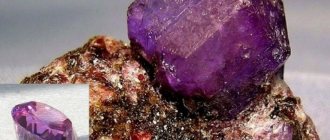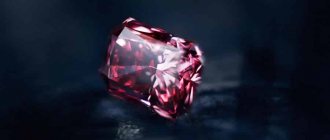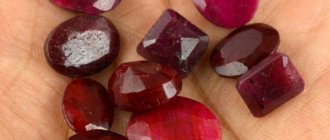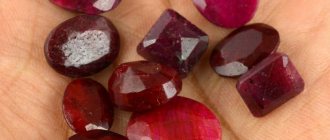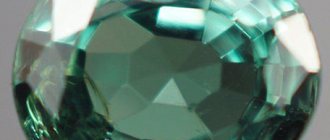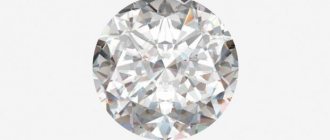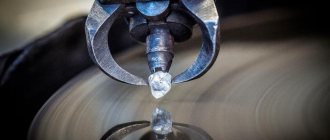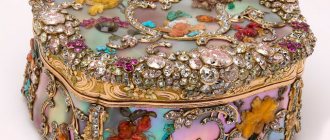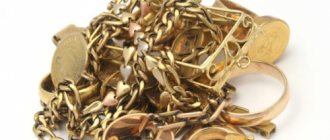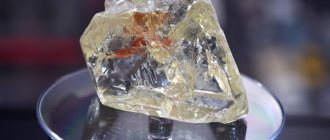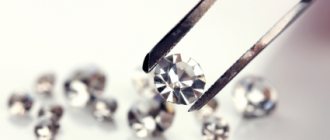Discovered less than a century ago, the amazing mineral of the borate family, painite, has created an unimaginable sensation in the gemstone market. And although since the discovery the number of stones mined has increased, this gem still holds primacy among rare gems.
Each cut piece is counted, and connoisseurs line up behind each of them in anticipation of a possible sale. For each of them, collectors are willing to pay money unprecedented even for diamonds...
History and origin
The rarest mineral in the world became known in 1956 thanks to the English scientist Arthur Charles Davey Payne. This is a man who devoted his life to the search and study of precious minerals. The collection of stones collected by Paine during his lifetime became the property of the Natural History Museum in London after his death.
While working at Oxford, Payne periodically left his native Great Britain in search of treasures. One of his expeditions to Burma (today Myanmar) at the age of 55 brought the scientist a truly great find of his life.
The mineralologist took three small orange-brown crystals found in the low mountains of central Myanmar for research in the laboratory of his native Oxford. The find was named after the discoverer “painite”, which makes it possible to pronounce both “painite” and “painite” in the Russian version.
After the discovery of the mineral, jewel hunters rushed to search for it. With the hope of finding rich deposits, prospectors explored all the lands of Burma, as well as other deposits of boron-containing ores. Over half a century of searching, gemologists have counted no more than twenty specimens of decent quality. Of the 85 existing types of borates, painite turned out to be the rarest.
A new deposit of painites was discovered in 2006 in the north of Myanmar (Mogok). Mineralogy was replenished with thousands of specimens of rare minerals, but only about three hundred of them were assessed as being of average quality, suitable for cutting. All samples were distributed to private collections. The same two dozen crystals that were found during the first half-century of searching were distributed to museums, laboratories, institutes, and some ended up with private collectors.
Among the institutions that own the first collectible painites are the Gemological Institute of the USA, the British Museum of Natural History, the Research Laboratory of Gemstones in Lucerne (Switzerland), and the California Institute of Technology.
Place of Birth
Only a few deposits are known for painite, which are located in Mogok (Burma). The best specimens found became the property of private mineralogical collections, and also adorned the collections of the British Museum of Natural History, the California Institute of Technology and the Lucerne Gem Research Laboratory.
Physical properties
Painite has a very complex chemical composition, being a compound of boron, calcium, aluminum, zirconium and oxygen. Contains vanadium, chromium, and iron as impurities. Formed by hexagonal crystals.
Painite is quite hard, endowed with pronounced pleochroism, and is also resistant to almost all external influences (sunlight, moisture, mechanical damage, acids). The mineral fluoresces green in ultraviolet light.
| Formula | CaZrBAl9O18 |
| Color | ruby red to brown-orange |
| Stroke color | white |
| Shine | Glass |
| Hardness | 7,9-8,0 |
| Density | 4.01 g/cm³ |
| singonia | Hexagonal |
How to care for stone
One of the advantages of painite is its ease of care and storage.
The stone is not afraid of direct sunlight, high humidity, and temperature changes. This mineral has a high coefficient of hardness and density, so it is resistant to impacts, scratches, falls and squeezing.
The stone is not affected by acids and alkalis, but it is still not recommended to clean it with abrasives and allow chemicals to get on its surface. To wash the gem, use warm water and a mild soap solution. Immediately after rinsing, wipe the stone dry with a flannel cloth.
Painite should be stored in a separate box so that it does not damage softer minerals.
Areas of application
The long-term rarity of painite after the first discovery determined the only purpose of the stone - collection. After the opening of a new mining site, the number of specimens increased, but the situation has changed little - most of the nuggets are unsightly, unsuitable even for collecting. The cut samples can be counted on one hand; their owners are known by name.
The same stones that crown individual exclusive jewelry determine the exorbitant cost of such jewelry and are sold at auctions without establishing an upper limit value.
encyclopedia "stones"
All types of natural stone play a different, but important, meaning in the life of each of us. By visiting our online portal, you can find out comprehensive information about all kinds of this natural material, which is used both in construction and creating jewelry, and for the purpose of healing the human body. All material on the site is divided into subcategories, which makes it more convenient to use.
Main headings
The following sections are presented to the attention of people interested in different types of stones, their properties, meaning and application features:
- Basalts. By visiting this section of our website, you will learn what the materials belonging to this effusive rock are, and also become familiar with the features of their use in construction. Based on basalts, building materials such as basalt wool and basalt cardboard are made, which perform thermal insulation functions. This section will also allow you to get acquainted with the best manufacturers of basalt fiber.
- Volcanic stones. The properties and applications of syenite, peridotite, labradorite, andesite, aplite, liparite, granodiorite and other volcanic rocks are all described in detail in this section of our website.
- Granite. Everyone has probably heard about such a stone as granite, because it is the most common rock. However, not everyone is familiar with the peculiarities of origin, production, varieties and all the subtleties of using granite. If you visit this section, you will also gain useful information about the technology of wall cladding with granite.
- Precious. Stones belonging to this category of natural materials attract many women. By visiting this section, you will receive a comprehensive answer to questions about such precious stones as diamonds, tourmaline, Paraiba, verdelite, opal, topaz, zircon, alexandrite and others, mainly used in jewelry.
- Quartzites. Are you interested in questions about how quartzite is mined and processed, what the material is and what types of it exist? This means that the information presented in this section of our website will be useful to you.
- Corals. Coral is a noble stone that comes in many varieties in nature. Here you will receive comprehensive information about this natural material, used both in construction and in jewelry.
- Landscape stone. In landscape design, in the process of landscaping home gardens and park areas, a large number of different types of natural stone are used. This category consists of rocks such as decorative sandstone and limestone, boulder, cobblestone, goldstone and other stones. In addition to information about these rocks, this section describes possible options for landscape work using these types of stones.
- Mineral stones. Almost all minerals are widely used in the life of modern man. These are such well-known stones as amber, azurite, adularia, aventurine, zircon and many others, which are distinguished by their unique properties, allowing the use of materials in construction, jewelry and medicine.
- Marble. Marble products have always been considered the standard of luxury and wealth. If you are interested in the properties, as well as features of the use and processing of this stone, visit this section of our website.
- Facing stones. Don’t know yet what kind of stone is best to line a stove in a private house or how to use shell rock for construction and facing work? Study the material presented in the “Facing stones” section, which also contains information about the possible types of this material for cladding, its properties and application features.
- Finishing. Which stone is best for finishing, which natural stones are used in interior design in different styles - these are questions that often concern novice builders. Visit the “Finishing Stones” section, here you will find comprehensive answers to these and many other questions. In addition, get acquainted in detail with the features and properties of such natural finishing materials as dolomite, limestone, shungite, sandstone, slate and some others.
- Ornamental stones. When creating magnificent jewelry and interior items, such types of ornamental stones as amber, lapis lazuli, malachite, jasper, heliotrope, charoite, jadeite, hematite, agate, and onyx are widely used. You will learn about the properties and features of using these stones in creating many crafts in this interesting section.
The “Articles” section makes it possible to find out a lot of educational information about how various types of natural stones are processed and used, as well as about their properties and even the effect on the human body. All this and much more about this type of material, such as natural stones, is described in as much detail as possible on our website.
On this topic
Natural facing stone for finishing residential premises.
Medicinal properties
Since painite was discovered relatively recently, its beneficial properties are under study. The already known healing properties extend to the human cardiovascular system, gastrointestinal tract, and endocrine glands.
The discovery of new specimens at the dawn of the 21st century helped lithotherapists engage in a broader systematic study and use of the mineral. Thus, the medicinal properties of painite regarding infectious diseases such as lupus erythematosus, measles, smallpox, and erysipelas are at the research stage. It is also known that wearing a bracelet with a mineral helps maintain youthful skin.
Jewelry with painite and prices
It is almost impossible to find jewelry with painite in jewelry stores, since their cost is extremely high. Basically, these are exclusive handmade items, the price of which at auctions has no upper limit.
Today, high-grade painites, which were the first to be discovered, are not available on the stone market. Jewelry with low-quality faceted painites is on sale, the cost of which at auctions can reach $300,000 per 1 carat.
Unprocessed low-quality mineral fragments cost between $10-15 per gram.
Magic properties
Despite little knowledge, esotericists managed to find out that painite works as a talisman for a home or building against the elements, robbery, and dangers. It is also known that the mineral patronizes gambling people, helping to win disputes and gambling.
But at the same time, the nugget demonstrates unpredictability; its energy is not controlled by the owner, so you should be careful when using the talisman.
But for high-ranking individuals, painite brings good luck when concluding risky transactions, guides the owner, protecting him from rash decisions.
In order for painite to work at full strength, the stone should be charged with solar energy. It is important to remember that the stone gains strength only from the rising sun. The energy of sunset, on the contrary, takes away the magical abilities of the gem.
A rare nugget patronizes energetic, purposeful, and cheerful individuals. The stone will give such people protection not only in business matters, but also in love endeavors.
It has also been noted that a mineral with a pronounced orange tint reveals the gift of clairvoyance. For magicians, such an amulet facilitates the process of predicting the future and fortune telling on cards. An ordinary person will be able to see prophetic dreams, and in moments of mortal danger, the owner will be able to avoid the inevitable. In order to receive patronage, it is not necessary to have a collector's item. Even the smallest, inconspicuous pebble is enough to become a faithful assistant.
Painite is beautiful and useful
Painite, like most other crystalline minerals, is not free from impurities. A brownish-brown hue, sometimes thick to the point of opacity, is given to the painite massif by oxidized iron molecules. The natural color of prismatic painite crystals is orange-red. Impurities of chromium and vanadium change the shade of the stone.
The pleochroic nature of the mineral is manifested by a color change from ruby red to brown-orange when the sample is viewed in perpendicular directions. The high hardness and bright shine of the polished surface of the stone make it a desirable material for jewelers.
However, due to the natural rarity of the mineral, jewelry made from painite is rare and sold at an unpredictably high price. The reverent attitude of the lucky ones who possess the treasured stone is also expressed in the quickly emerging superstitions. It is believed that painite accelerates the achievement of the goal in the love “hunt”, and also helps the gambler.
To “maintain strength”, faceted painite should be exposed to the rays of the rising sun - and under no circumstances should it be shown to the setting sun...
Astrological compatibility
Painite is considered a stone of the fire element, therefore it patronizes the corresponding signs of the Zodiac - Leo, Aries, Sagittarius. The gem brings good luck to these people in all matters and makes them attractive to the opposite sex.
For men, the talisman promises help in overcoming life's obstacles, and for women - finding sincere love.
Painite and zodiac sign
Painite is suitable, first of all, for zodiac signs representing the element of Fire (Aries, Leo, Sagittarius).
It makes them successful in the eyes of the opposite sex and brings them good luck in everything. Painite can give a woman sincere mutual love, and a man will become a faithful assistant in overcoming any obstacles and obstacles that arise along the way. Painite is recommended for bosses and everyone who holds high responsible positions; it is useful when concluding risky contracts. The stone helps to avoid rash actions and is a source of good luck.
Interesting Facts
In 2005, a year before the discovery of the deposit in northern Myanmar, painite entered the Guinness Book of Records as the rarest mineral on the planet.
Today, mineralogists have 18 painites of ideal jewelry quality, of which only 3 are perfectly pure red stones. If such stones are put up for auction, a queue forms behind it, and the lot is sold at lightning speed for an incredible price. Another 330 examples (as of 2009) from around the world are considered suitable for jewelry making.
Since the discovery of the mineral, only 10 stones have been cut, the largest of which weighs 2.54 carats. Over the past three decades, demand for painite has generated a 30-fold jump in price. If we take diamonds as a comparison, their price has only doubled over the same period of time.
Painite is one of the ten most expensive substances in the world, occupying third position after antimatter and californium. One gram of the highest quality mineral is estimated to be worth $300,000.
Applications
Since the first discovery of painite, for a long time only a few specimens of it were known, which did not allow this stone to be used in any way.
Fortunately, several new mineral deposits containing more large gems have been discovered in Burma in recent years. However, to date, only 10 examples of painite have been cut worldwide. For this reason, their prices are prohibitively high. Over the past 30 years, it has increased approximately 30 times, while, for example, diamonds have only doubled in price. It is very rare to find small-sized untreated painites on the jewelry market, but similar specimens are very highly valued.
